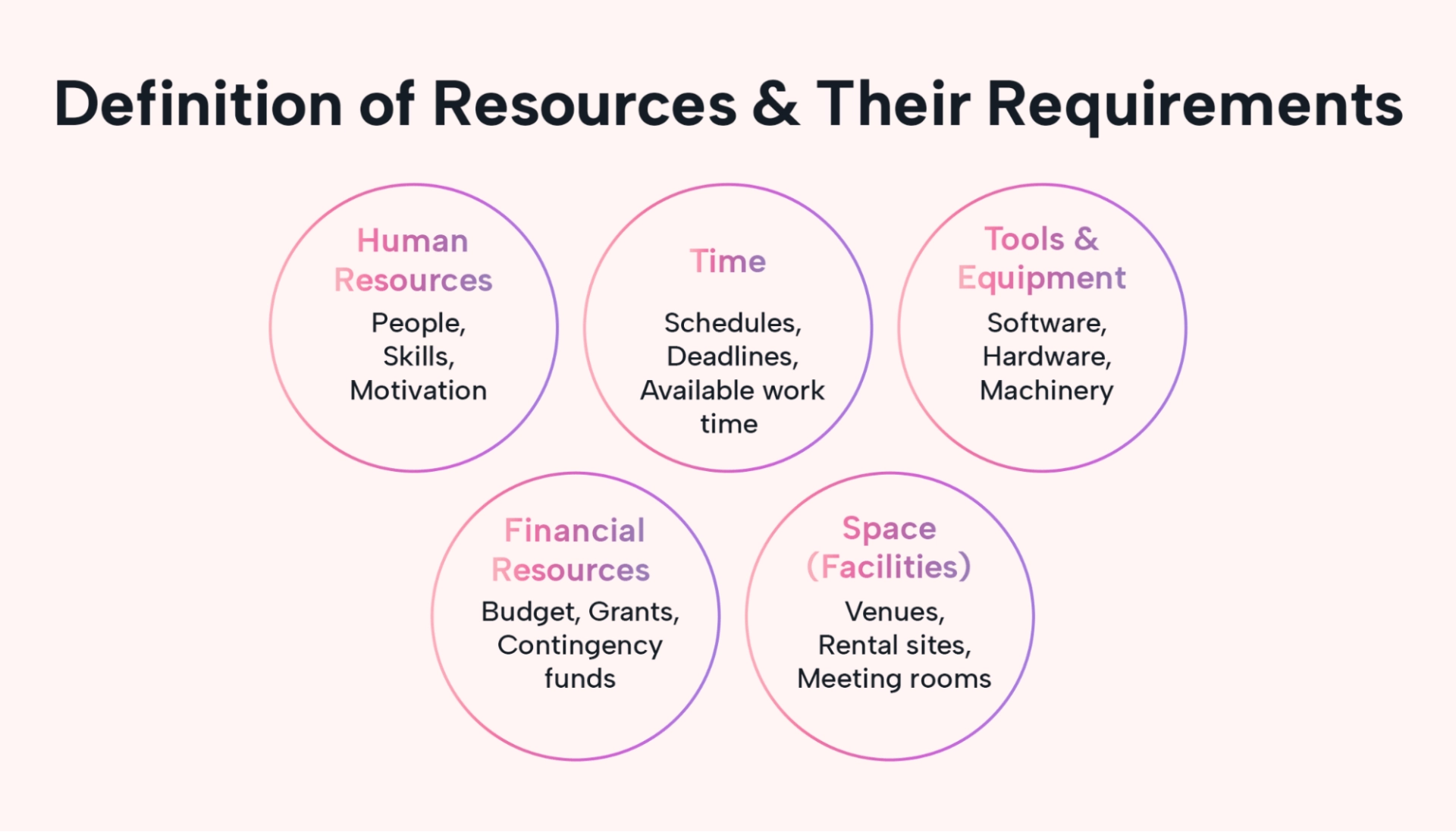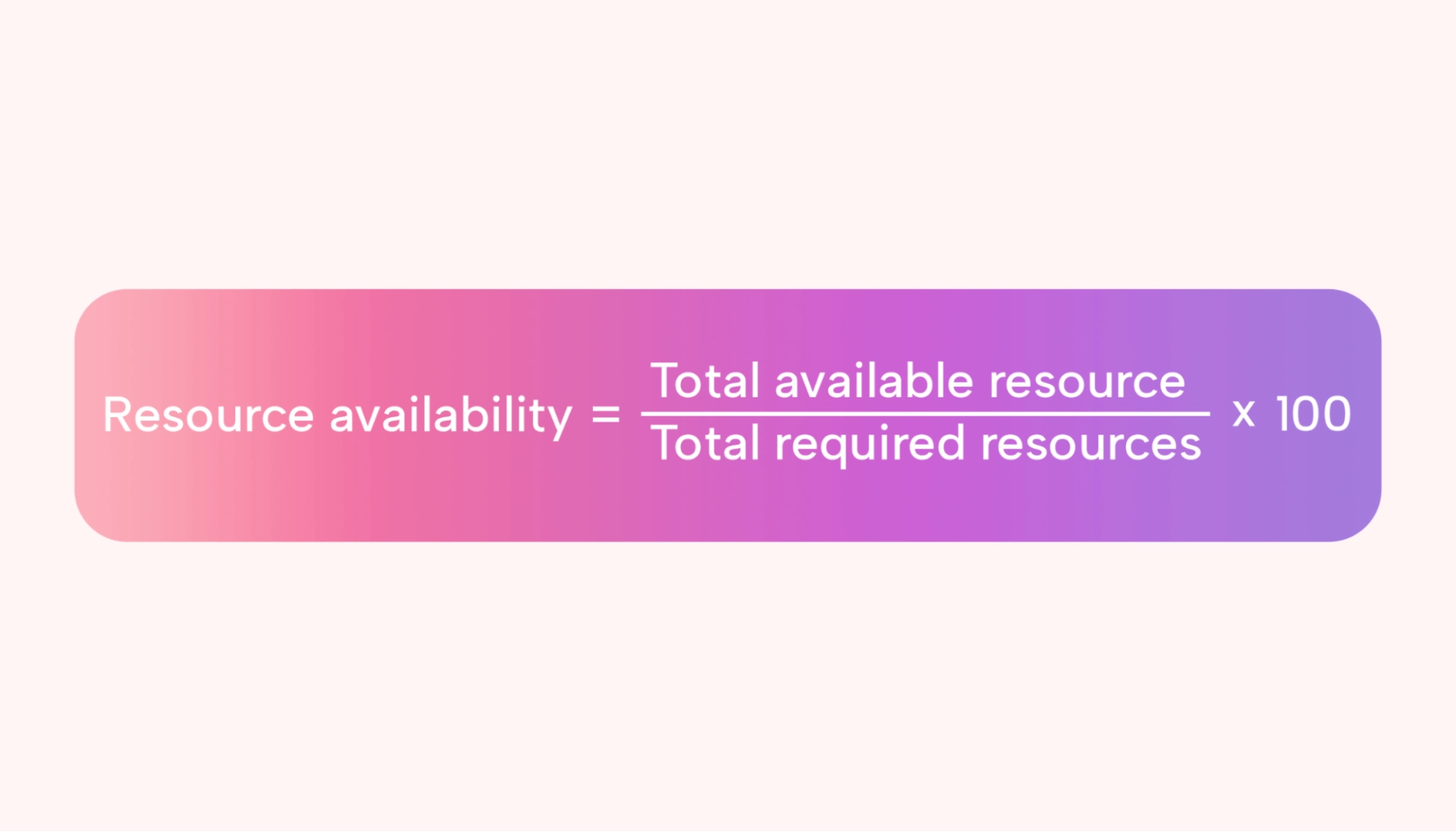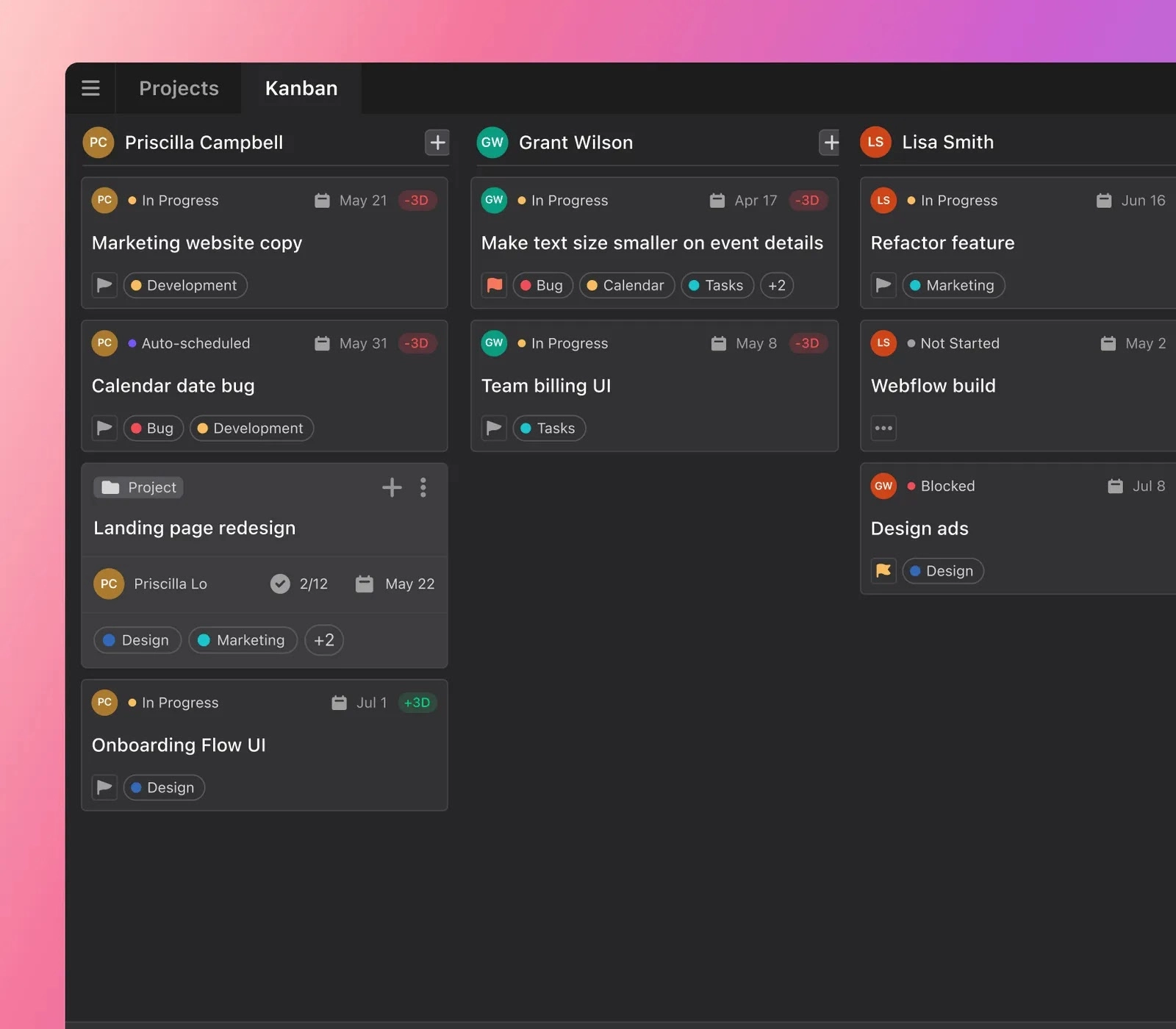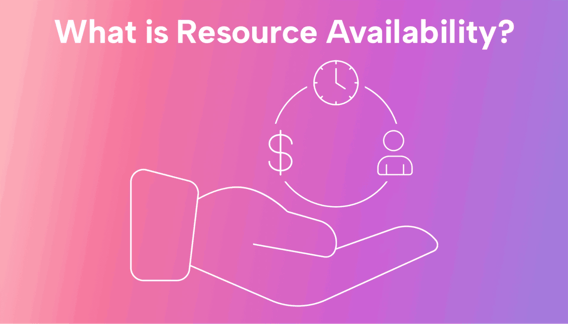Double-booking. Scheduling conflict. Understaffed. Over budget. Missed deadline.
These are some terms that nightmares are made of for business owners and project managers. And they typically come alive if you do not understand your resource availability. That’s why you want to track and manage it.
Resource availability serves as the heartbeat of successful project management, influencing the progress of every task and milestone.
In this article, we’ll define resource availability, the benefits of allocating and managing it correctly, and what affects it.
What is resource availability?
We all know project resources can be people, money, time, materials, supplies, or equipment. It’s their accessibility at a given time for any task or project that’s called resource availability.
Why is it important?
You can’t get a project off the ground without the availability of the necessary resources.
As a business or project manager, you’ll have to determine resource availability from the get-go during the resource planning stage. Once that’s done, your job isn’t over!
Track resource availability throughout your project life cycle so you can manage it according to the project’s progress and needs. That’s the only way your project will touch the finish line.
Types of resources and their availability
To understand the availability of your resources, here are the different types of resources you’ll typically deal with:
- People resources: Resources whose availability will define how many people with the right skills are ready to take on how much work and when. Managing people resources is the most challenging part of most projects. That’s why this article will heavily focus on people resources.
- Time: How much time do you have to complete a specific task or project? How long will this take? And is the time frame enough? These questions will help define your time resources.
- Tools or equipment: Does your team have the right software, hardware, equipment, supplies, or tools to complete a project successfully? The availability of this resource will ensure that human resources can do their job in a timely fashion.
- Financial resource: What’s your project budget? Is it sufficient? Does it cover the resources (including employee salaries, software, and equipment) you plan to use?
- Space: Space refers to physical facilities or locations like offices or rental sites specific to your project’s requirements. The availability concern is whether you have acquired it. When or for how long do you need it?

The resource availability formula
Can’t wait to start calculating the availability of resources? The image below shows a simple formula.

- Total available resources = the complete resource capacity or quantity currently accessible to you. Or the entire resource pool.
- Total required resources = the resource quantity or capacity needed to complete a specific task or project.
Let’s take an example. If you have 30 available employees and need 15 employees for a specific project, here’s the calculation:
Resource availability = 30/15 X 100 = 200%
A percentage over 100 implies a resource surplus (which is usually not the case).
Warning: This is a simple formula that typically doesn’t apply to complex projects because a lot of factors play a role in resource availability.
For example, it’s not just the amount of a resource, but quality too. In terms of human resources, you need access to the right skill at the right time, assessed against all the other concurrent projects demanding those skills.
Why is tracking resource availability important?
Tracking the availability of resources is crucial for several reasons:
1. Improves decision-making
When you can clearly view your resource availability, it becomes very convenient to identify the scarcity or excess before it can become a headache.
This means you can make important decisions regarding:
- Outsourcing excess resources.
- Making new hires.
- Trying freelancers or contractors.
- Setting up training programs to meet the gaps for project success.
Knowing your resource availability also helps you set goals you can achieve and create precise and realistic project timelines.
2. Enhanced productivity and efficiency
The superpower of knowing your resource availability lets you decide who works on what task, utilizes what tool, and uses how much of the budget.
How?
Resource availability reveals who’s good at what (skill and experience), the total funding, and the workload capacity. Because of this awareness, you’re not throwing darts in the dark. Only the right people with the right expertise work on project tasks.
This screams enhanced productivity and workflow efficiency!
What’s more?
With the awareness of your team’s availability and workload, you can dodge the possibility of burnouts and bottlenecks — creating a healthy work environment that boosts productivity.
3. Accurate resource scheduling
You can analyze your team’s work capacity and expertise for accurate resource scheduling. Once you know the right person to assign to the right tasks, you can prevent delays and double bookings.
4. Minimize costs
Managing resource availability means you always know if you have enough of the right people, time, or equipment to complete your project. This means no resource cost-related surprises like unplanned additional hires in the middle of a running project.
Moreover, since the right people or resources are put on the right tasks, the quality of your deliverables can skyrocket. It’ll also reduce missed deadlines, project delays, and costs associated with such situations.
Note: Managing resource availability also helps you plan for hires or perform training before the project starts.

5. Superior risk management
Having the right resources is a major benefit in the dynamic world of project management.
For example, if your project scope changes or there’s an additional resource demand, an approved change request can allow for more resources (and budget and schedule). This will protect you from the risks associated with such changes and uncertainties so the project’s progress doesn’t stop.
Managing resource availability also allows managers to:
- Plan for and accommodate leaves and vacations since they’re aware of each employee’s available work time.
- Set contingency plans for unplanned attrition or leaves. For example, they can have backup employees ready to rely on to deal with uncertainty.
6. High-quality deliverables
Consider resources as the ingredients for a cake recipe. You can make a superior-quality cake when you have all the right and essential ingredients. In this case, the cake is a high-quality deliverable.
But here's the kicker: Just like too much flour can make your cake flop, overloading your experts with tasks they're not specialized in can reduce the quality of deliverables. But with access to resource availability, you can follow the recipe (the right skills for the right tasks)!
As a result, you’ll keep your expert resources happy and well-balanced, who’ll churn out grade-A deliverables!
7. Performance assessment
Knowing your resource availability lets managers allocate tasks to employees according to their available time and skills. This produces an opportunity for them to assess employee performance.
For example, can a specific human resource take on an ‘x’ amount of task work while maintaining quality? This will help your managers better understand the resource’s productivity and plan future assignments.

How to optimize resource availability
Let’s see how to optimize resource availability for higher productivity:
1. Align your project schedule and resource calendar
Let’s face it: No matter how solid your project plan is, a lack of resource availability can happen in the real world and change all that.
For example, your team members will fall sick sometimes (unplanned) or take a vacation (planned). And that means your deadlines can be affected. So, you have to align your resource calendar to your project schedule. Here’s how:
- Ensure resource calendars are updated in real-time.
- Make sure assignments can be updated when available work time changes (flexibility).
This is best done using a scheduling tool like Motion, which can track every resource’s available work time. When there’s a change in resource availability, Motion will automatically adjust the task timeline in real time to reflect the new optimal schedule.
Lastly, define assignments and expectations well. This will help employees realize precisely what’s expected and avoid confusion — which can lead to excess time and cost.
2. Centralize your visibility
Next, you want to use a tool that’s aware of your resource availability. This should ideally include resources for all activities and not just project work.
Why? Because sometimes you may need resources that weren’t part of the initial project plan (projects are ever-evolving). When that happens, the centralized view will protect you and your team from over-allocation and scheduling conflicts.
3. Anticipate your team’s skills and training needs
This one is specific to human resources. To optimize resource availability, anticipate the skills your team needs to keep up with current and future demands.
Then, encourage employees to upskill and provide the necessary training in advance. You can even reimburse employees for relevant training.
Why do all this? Organizations that invest in building skills considerably increase employee retention. As a result, you’ll have high-quality resources that can meet client expectations.
Additionally, ensure your company uses modern tools where employee skills can be updated in real time.
4. Your scheduling system should understand accidental over-allocation
Ever fought for the same employee that another manager wants?
Sometimes, resources get shared.
Result? Internal resource conflicts between project managers.
The only solution: Use an intuitive and centralized scheduling system that understands accidental over-allocation and adjusts for it — just like Motion does. For example, if a task changes or slips, Motion can rearrange the schedule for tasks to maintain the project deadline. If your task specifications show that you can’t meet the deadline, Motion will let you know so you can make realistic resource allocations or other adjustments.

5. Reduce meetings that don’t add value
According to a recent article, 70% of meetings are a waste of time. That’s a large percentage!
While meetings and admin are important, they can take up your competent employees’ time that could be used for project work. So, how do we escape this vortex of wasted time? You and your team can set limits on meeting durations so there’s more time for actual work.
Looking for a tool that helps you do so? Motion has you covered.
How to manage resource availability
Here are some best practices for managing resource availability like a pro:
1. Opt for a centralized system
First, you want all your resource-related information on a single platform.
Why? It saves time that you’d spend collecting information from different platforms. Additionally, a single source of information provides project and resource managers with clarity about resources to make effective decisions.
For example, you can use a project management tool like Motion. It simplifies resource management using information like priorities, deadlines, dependencies, and available working hours.
You and your team can even block time for specific activities or personal appointments. Motion’s AI takes it from there to build optimal calendars and schedules automatically to utilize your available resources most effectively.
Moreover, projects rarely go exactly how you want them to. Motion AI adapts. It automatically revises task schedules when a new urgent task or other change arises.
Once the AI has done its magic, you can use Motion’s Kanban, project, or resource views to visualize the work in progress and move things around. Maybe give one of Priscilla’s tasks to Grant or reassign one of Lisa’s, as in this view of work by individual resources.

2. Create and manage a skills inventory
Create and manage a skills inventory. It involves systematically cataloging and documenting individuals’ skills.
Why should you do this? When you plan a project that requires certain skills, you'll know exactly who has them. Just glance at your trusty skills inventory.
Pro tip: Make sure you keep the skills inventory up-to-date, or there’s no point in it. It must include both current skills and future needs of each resource.
3. Determine the resources you need
Estimate the resources you’ll need to complete each task in the project. To do so, determine the skills and effort required for each task. Or employ a suitable estimation technique to make the process easier.
For example, try bottom-up estimating (one of many estimation techniques). You and your team divide every complex project activity into smaller bits to determine the resource demand for each. Then, you can add them to get a total of your resource needs.
4. Prioritize allocation of resources (considering organizational objectives)
Managing resource availability would be a failure if you didn’t prioritize projects. How else would you allocate resources effectively?
So first, make sure the projects you select support your organization’s goals and objectives. This is a better approach than starting any or all projects that come your way. Would you rather do 100% of 10 projects or 10% of 100 projects?
5. Allocate resources strategically
In the case of human resources, match their skills and expertise with the requirements of each project. Second, don’t forget to consider the criticality and urgency of projects when allocating resources.
Lastly, check for over-allocation while scheduling. Or just use a tool to prevent it from happening.

Try a unique approach to resource management with Motion
Tracking and managing resource availability is a critical factor that defines project success. And clearly, multiple factors can affect your resources. Failing to consider them will result in major bottlenecks.
That’s why you need to track and estimate resource availability thoroughly. And guess what? Motion can help.
Its AI scheduling features consider your team’s priorities, deadlines, available work time, and dependencies to create and revise their calendars for optimal utilization automatically.
But most importantly, Motion’s AI-powered Intelligent Calendar knows what’s most important for each person to work on next, today, or next week. It automatically revises them when things change, or a new and urgent priority arises. And when it can’t meet a deadline per your specifications (you’ve asked it to do the impossible), it alerts you so you can fix it. Otherwise, rest assured that your resources are never over-allocated and you are constantly working on the right thing at the right time.
Sign up for Motion today to automate your resource conflicts and optimize your resource availability!

Shinjini is a SaaS and project management writer with an annoying love for heavy research. She’s been through the whole 9-5 grind, churning out content for writing mills, but she also knows her way around freelancing for big SaaS players. When Shinjini’s not buried in articles, she’s either on a Google rampage for healthy recipes or petting her neighbor’s dog.




